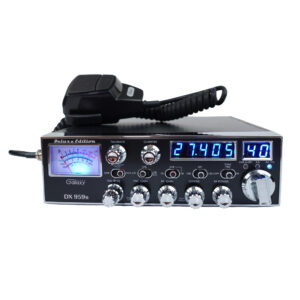The Citizens Band Radio Service, or CB, as it is commonly called, is a type of radio communication under the category of Personal Radio Service. As with the other types of PRS, such as FRS, GMRS, MURS, and LPRS (Low Power Radio Service), CB is intended for both consumer and business use. CB is covered under Part 95 of the FCC rules. A CB radio does not require a license to operate.
CB service operates on 40 shared channels in an AM mode or Single SideBand (SSB) mode. SSB offers less noise and greater range than AM mode and is usually found on higher end CB radios. SSB has two modes, Upper Sideband and Lower Sideband. You can only communicate with other SSB CB radios when in SSB mode.
There is no minimum age requirement to operate a CB radio. In fact. almost anyone can use CB. According to the FCC rules (95.403) "you are authorized to operate a CB station unless:
(a) You are a foreign government, a representative of a foreign government, or a federal government agency; OR
(b) The FCC has issued a cease and desist order to you, and the order is still in effect."
CB channels and frequencies are not assigned to any specific individual or organization. For the most part, you can operate a CB radio on all 40 channels and frequencies designated by the FCC for CB, but there are some caveats.
First, you can use CB only on those 40 channels and frequencies. Channel 9 may be used only for emergencies or for travel In addition, however, any channel can be used for emergency communications or traveler assistance. In addition, as these channels are shared, you must always give priority to emergency communications on all channels.
The maximum power levels for CB operation depends on the type of signal you are transmitting. AM signals are allowed a maximum of four watts. SSB mode is allowed up to 12 watts Peak Envelope Power, or PEP. According to the FCC, you are not allowed to raise the power output of your CB unit, attach any type of power amplifier, or modify the unit internally. Also, according to the FCC, you must use an FCC-certified CB unit in the United States. FCC-certified CB units have an FCC-certified label placed on the radio by the manufacturer.
CB is intended for short range, local communications only, but there is a way to increase range considerably by bouncing or "skipping" the signal off the ionosphere. This method is called 'shooting skip". Some CB users can skip a signal thousands of miles. The FCC prohibits attempts to communicate with CB stations over 155.3 miles (250km) away; however, signals can skip naturally depending on tropospheric conditions, so it is not unusual to send or receive CB transmissions across the country - or even around the world - unintentionally.
Because the 40 CB channels are shared with other users, some common etiquette is required. users must never talk with another station for more than 5 minutes continuously and must wait at least one minute before starting another communication. In the early days of CB the FCC did require users to have a license and a call sign. While neither is no longer necessary, it is still common practice to have a "call sign" in the form of a pseudonym, or CB "handle". The FCC allows users to create their own handles.
CB users also have their own lingo and codes. 10 Codes are the universally accepted standard for CB transmission in AM mode while Q Signals are generally used for Single Side Band and by skip-talkers. For more information, download our FREE list of CB 10 Codes and Q Signals.
CB radio equipment is also standard. Popular brands include Cobra, Galaxy, Midland, President, Uniden and Wouxun. Cobra is one of the most recognized and established brands of CB radio equipment in the world. There are two basic styles of CB Radios from these manufacturers: mobile (usually mounted in vehicles) and handheld (as with standard two way radios or walkie-talkies). Mobile units cost between $40 and $200. The Uniden PC68LTW, Galaxy DX 959 SSB, and Cobra 148 GTL SSB are all mobile CB radios offering many premium features for seasoned CB users on the high end. For the beginning CB user, equally mobile Uniden PRO510XL is a good, basic, entry-level radio priced at only 39.99. Handheld CB radios, such as the Cobra HH-Roadtrip and HH 38 WX ST CB Radios, usually cost between $40-$180.
When purchasing a CB radio, one thing that must not be overlooked is the antenna. While antennas are often included with handheld CB radios, they are not included with mobile units and must be purchased separately. Whether it is an entry-level unit or one on the high-end, performance will depend a lot on the type of antenna purchased and where it will be mounted. Consider your options carefully before purchase.







